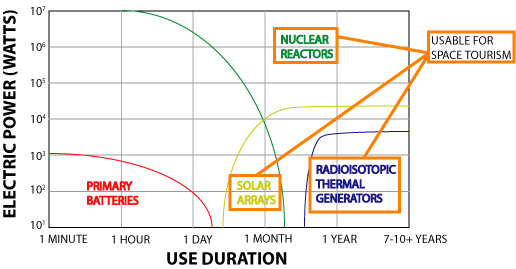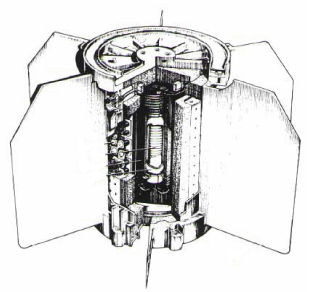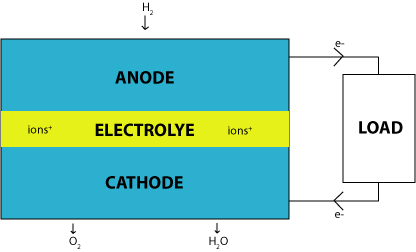Space Tourism
Abstract
The interest in space tourism has increased dramatically since the beginning of the 21st century. With companies like Virgin Galactic making significant progress, albeit with some failures, people are beginning to take the industry seriously. With the huge amount of systems that are integrated in a space craft, the need to engineer an efficient and reliable power source is key. Electrical engineers’ education and expertise enable them to design such crucial systems. This article will discuss three methods of power generation and their usefulness for space tourism: solar, nuclear, and fuel cells.
Article Text:
Background
In 1968, Arthur C. Clarke imagined a future in which humans could travel back and forth from orbiting space stations via luxurious space craft. His vision was famously captured in Stanley Kubrick’s film adaptation of his novel 2001: A Space Odyssey. In the film, tourists travel with ease to futuristic space hotels which they use as a jumping off point to get to the moon and other celestial bodies. Perhaps inspired by Clarke and other science fiction writers, humans are now closer than ever to making this vision a reality. Although the idea of space tourism originates in science fiction, serious consideration has been given to the field in recent years.
What is Space Tourism?
The term “space tourism” describes any kind of human space travel intended for recreation, business, or other non-scientific purposes. There is currently a small number of companies working on offering such services including Virgin Galactic, XCOR Aerospace, and Armadillo Aerospace. The existence of these companies is evidence of the interest in space tourism and that it is becoming a reality. The ability to travel into space will allow people the opportunity to experience the wonderment of the universe more intimately than any terrestrial method. Additionally, commercial space flight can drastically reduce the time to travel between points on the earth. Instead of conventional air travel, space craft could travel above the Earth’s atmosphere to reach different locations. What was once a 16 hour flight may be reduced to merely 2 hours (Abeyratne, 2013). Though companies have made progress in the field of space tourism, there are still significant challenges associated with bringing commercial space travel to the general public.
The Challenges
Obstacles associated with cost, regulation, and technology plague the space tourism industry. Many of the challenges, however, are largely technological. Engineers are experts in solving technological problems and are thus a driving force in pushing recreational space flight forward. Nonetheless, a brief discussion of the previously mentioned obstacles is necessary to appreciate the scope of touristic space flight before a more detailed investigation of engineering roles.
The most visible challenge associated with bringing about space tourism is the cost. Virgin Galactic is now charging $250,000 a seat for a ride on their SpaceShipTwo suborbital spaceplane. Although that price tag is far out of reach for the average consumer, it is much less than the $70 million Russia charges to ferry US astronauts back and forth from the International Space Station (ISS). This disparity highlights the progress that has been made in reducing the cost of getting people in space. Currently, companies working on space tourism are aiming to sell tickets to the super rich; however, the technologies used are continually being researched and will eventually become affordable to a wider group.
The proliferation of space tourism would have to be regulated in some way, similar to how the FAA regulates air travel. Guidelines would have to be put in place for safety, communication, air traffic, and the myriad of other associated issues. Space flight is currently administered internationally by the Outer Space Treaty of 1967. This treaty provides the basis of space law. It governs any space flight that qualifies as “national activity in outer space”. There is some debate about how private and commercial space flight fit this definition (Dunk, 2011). Although some countries, including the United States, Russia, and Norway, have adopted laws concerning commercial space ventures, there remains the need for an international discussion on how to regulate commercial and touristic space travel and what type of organization should be held responsible.
Though there is an enormous amount of obstacles associated with commercial space flight, this article will focus on those relating to energy for the space craft. Power generation is perhaps the most crucial aspect of any space craft. Electrical engineers design ways of generating, distributing, and consuming power in such a vehicle. Their expertise allow them to make the best informed decisions for these crucial systems. Energy systems determine the type and how much fuel will be consumed, how efficient the energy transfer is, and the weight of the vehicle. All of these factors greatly influence the cost of a space flight. In order to make space tourism a reality, the cost of a flight must be as inexpensive as possible. The value of certain methods in the context of space tourism will be evaluated in this article.
Space Craft Power Sources
In any vehicle, there is a need for a highly efficient power source. A more efficient source provides less fuel consumption, reducing the cost of running the vehicle. The energy source of a space craft provides power to all the electrical systems on board. Since space ships are so isolated, power systems on these vehicles must be extremely reliable and efficient to guarantee the safety of the people on board as well as of the ship. A power failure in orbit can be catastrophic to both the crew and ship. In space vessels, the need for highly efficient sources of energy is paramount.
The effectiveness of several possible energy sources for space vehicles is shown in Figure 1.

Figure 1
Space craft energy source capabilities. Source: Author, derived from Scott (2009, p. 1).
This plot was created in the 1960’s and has not changed very much since its formulation. The development cost of each of these technologies, however, has decreased drastically (Scott, 2009). Tourist space flights or journeys could potentially last anywhere from a few hours to weeks or months. Depending on the size of the space craft and the amount of passengers, commercial vehicles could use fuel cells, solar arrays, or nuclear reactors. Each source has different strengths and weaknesses so engineers’ decisions on which to use must be thoughtfully made. Some considerations for each of the aforementioned sources are detailed in the following sections.
Solar Arrays
Currently, many orbiting space vehicles, including the ISS, use solar cells to generate power. Solar cells have the advantage of a constant, predictable, and a virtually unlimited source of power. With those advantages, however, come drawbacks. Low orbiting vehicles only have access to the sun’s energy while in direct sunlight, creating the need for a battery. Since the sun is a practically infinite source of energy, solar cells are only limited by their efficiency in converting solar energy to electrical energy.
Engineers and scientist are constantly striving to make better solar cells. Currently, engineers are doing much research into cheaper and more effective processes of manufacturing solar arrays to achieve their highest potential. In 1999, NASA established a group called the Space Solar Power Exploratory Research and Technology Program (SERT) whose sole purpose is to develop new and better solar technology.
The maximum theoretical collection efficiency of a solar cell in space is 1353 W/m2 (Francis, 1988). This metric illustrates a key issue with solar cells, their size. A Boeing 747 passenger aircraft consumes roughly 140 MW of power during a typical flight. At the absolute least, it would require more than 100,000 m2 of solar cells, roughly the size of 10 city blocks, to generate this same amount of energy on a space craft. The size of such a craft would make it prohibitively expensive. It is additionally clear from Figure 1 that they are not easily scalable enough to produce enough power for a large flight with many people. Obviously, solar cells as a power source on their own would not be possible for touristic space flight.
For some craft, however, solar cells are quite useful. Satellites and other unmanned vehicles do not have the same power or size requirements of a touristic space vehicle; thus, useful solar arrays may be reasonably sized.
Solar cells do have the advantage of being light for the amount of power they generate. The metric used to measure this quality is called specific power, which describes the amount of power generated by a source per unit of mass (W/kg). Typically, solar cells have a specific power in the range of 30-60 W/kg, depending on the configuration of the cells. Solar cells would work well for short flights with a small number of passengers.
Nuclear Reactors
Nuclear reactors have been considered as a source for commercial space flight applications, which would provide a huge amount of energy. Compared to other methods, this could potentially allow manned vehicles to stay in orbit much longer. As shown in Figure 1, nuclear power reactors (Figure 2) would be used for longer voyages that require lots of power.

Figure 2
Radioisotope thermoelectric generator. Source: Author, derived from Stivers (1964, p. 657).
Since the 1960’s, many space vehicles have used nuclear fission reactors. These reactors are known as radioisotope thermoelectric generators (RTGs). RTGs take advantage of the radioactive decay of certain materials. This decay produces heat which can be converted in to electrical energy by a thermocouple. A thermocouple converts a temperature difference into a voltage difference. Engineers can use this voltage difference to power the electrical systems of a space craft.
In the past, RTGs have been used largely on long space flights that travel far from the Earth, away from the sun. In such flights, solar energy is not as prevalent. Additionally, adequate fuel for fuel cells would be too heavy to carry. Nuclear energy is highly suited to these applications. With RTGs, there is no need to see the sun or refuel a fuel cell.
Though RTGs are well suited for certain applications, they do not perform well for the types of tourist space flights that are currently being developed. Current RTGs have very low specific powers, in the range of 2–8 W/kg. Additionally, they are typically less than 30% efficient. These metrics make nuclear energy ill-suited for orbital and sub orbital commercial space flights. Perhaps in the distant future when humans travel deeper into the solar system this energy source will more useful.
Fuel Cells
Fuel cells are also commonly used on space vehicles. These devices convert the chemical potential energy of a fuel to electrical energy through a chemical reaction. Since fuel cells utilize a chemical process, no moving parts are needed for their operation. This quality allows them to be highly reliable and independent of gravitational changes, making them ideal for spaceflight. Fuel cells also have high specific power, perhaps the most significant metric in choosing a power source, as mass is a huge factor in calculating how much power is needed for a space flight.
As depicted in Figure 3, fuel cells work by reacting an oxidizing agent with a fuel, commonly hydrogen. This chemical reaction causes a current to flow between the cathode and anode of the cell. As with RTGs, engineers must design efficient circuitry around the cell to effectively use the current generated by the reaction. As byproducts, heat and water are created. The need for a constant supply of fuel and oxidizing agent differentiates a fuel cell from a battery. Additionally, a fuel cell does not need to be recharged or replaced like a battery and will create the same amount of electric current as long as it is supplied with fuel and oxidizer. This feature of the cell makes it an attractive power source. With enough resources, a fuel cell will run consistently and reliably.

Figure 3
Anatomy of a fuel cell.. Source: Author, derived from Scott(2009, p. 1816).
Fuel cells generally have a specific power that is better than that of solar cells. Due to this quality, they have been used as the main source of electrical power on the space shuttle missions. Alkaline fuel cells used on the shuttle have specific power greater than 100 W/kg. Research is currently being done into more advanced fuel cells that can have a specific power over 250 W/kg (Scott, 2009). These new fuel cells would be ideal for commercial manned space craft.
Conclusion
Power generation is perhaps the most crucial aspect of any space craft, commercial or otherwise. There are several sources of energy being currently used and developed. As in any discipline, different methods work better in different scenarios. For touristic space flight, the three methods of power generation considered were solar, nuclear, and fuel cells. Solar cells require a large area to generate a significant amount of power, leading to larger and thus more expensive space craft. Although their usefulness in space craft is well understood, their size make them questionable for tourist vehicles. Nuclear reactors are heavy and inefficient for near Earth space voyages. Fuel cells seem to have the best specific power and efficiency of the sources considered. They have additionally proved themselves very useful in past shuttle missions. Based on these facts, fuel cells seem to be the best suited for space tourism vehicles. Like with most space craft, however, engineers of tourist vehicles will likely rely on multiple power sources, taking advantage of the best aspects of each energy source. As engineers tackle the highly technical challenge of power generation, others are focusing on different problems including regulation and cost. Combining the talent of people from multiple fields will ensure a successful and profitable space tourism industry.
Bibliography
- Abeyratne, R. (2013). Commercial Space Travel: Security and Other Implications. Journal of Transportation Security 6(3), 257–270. DOI: 10.1007/s12198-013-0115-1
- Dunk, F. G. (2011). Space tourism, private spaceflight and the law: Key aspects. Space Policy 27(3), 146-152. DOI: 10.1016/j.spacepol.2011.04.015
- Francis, Robert W., Somerville, W. A. (1988). Issues and Opportunities in Space Photovoltaics. Retrieved from http://ntrs.nasa.gov/search.jsp?R=19890005800
- Scott, J. H. (2009). Fuel Cell Development for NASA’s Human Exploration Program: Benchmarking with ‘the Hydrogen Economy’. Journal of Fuel Cell Science and Technology (Transactions of the ASME) 6(2). DOI: 10.1115/1.2972170
- Scott, J.H. (2006). The Development of Fuel Cell Technology for Electric Power Generation: From NASA’s Manned Space Program to the ‘Hydrogen Economy., Proceedings of the IEEE 94(10), 1815-1825. DOI: 10.1109/jproc.2006.883702
- Stivers, George (1964). Radioisotope Thermoelectric Space Power Supplies. Aerospace (Transactions of the IEEE) 2(2), 652-660. DOI: 10.1109/ta.1964.4319650
Suggested Reading
- 2001: A Space Odyssey by Arthur C. Clarke
- Fredrickson, C.D. (1962). The effectiveness of photovoltaic solar cells as an electrical power source for space vehicles. Electron Devices Meeting, 1962 International 8, 48. DOI: 10.1109/IEDM.1962.187306
- Goehlich, R. A., Anderson, J. K., Harrold, N. N., Bemis, J. A., Nettleingham, M. T., Cobin, J. M., . . . Ilchena, N. Y. (2013). Pilots for space tourism. Space Policy, 29(2), 144-153. DOI: 10.1016/j.spacepol.2013.03.011
- NASA: http://www.hq.nasa.gov/office/hqlibrary/pathfinders/spacetourism.htm
- Martinez, V. (2009). Architectural design for space tourism. Acta Astronautica, 64(2-3), 382-390.DOI: 10.1016/j.actaastro.2008.07.014
- Space.com: http://www.space.com/topics/space-tourism/
- Virgin Galactic: http://www.virgingalactic.com/
